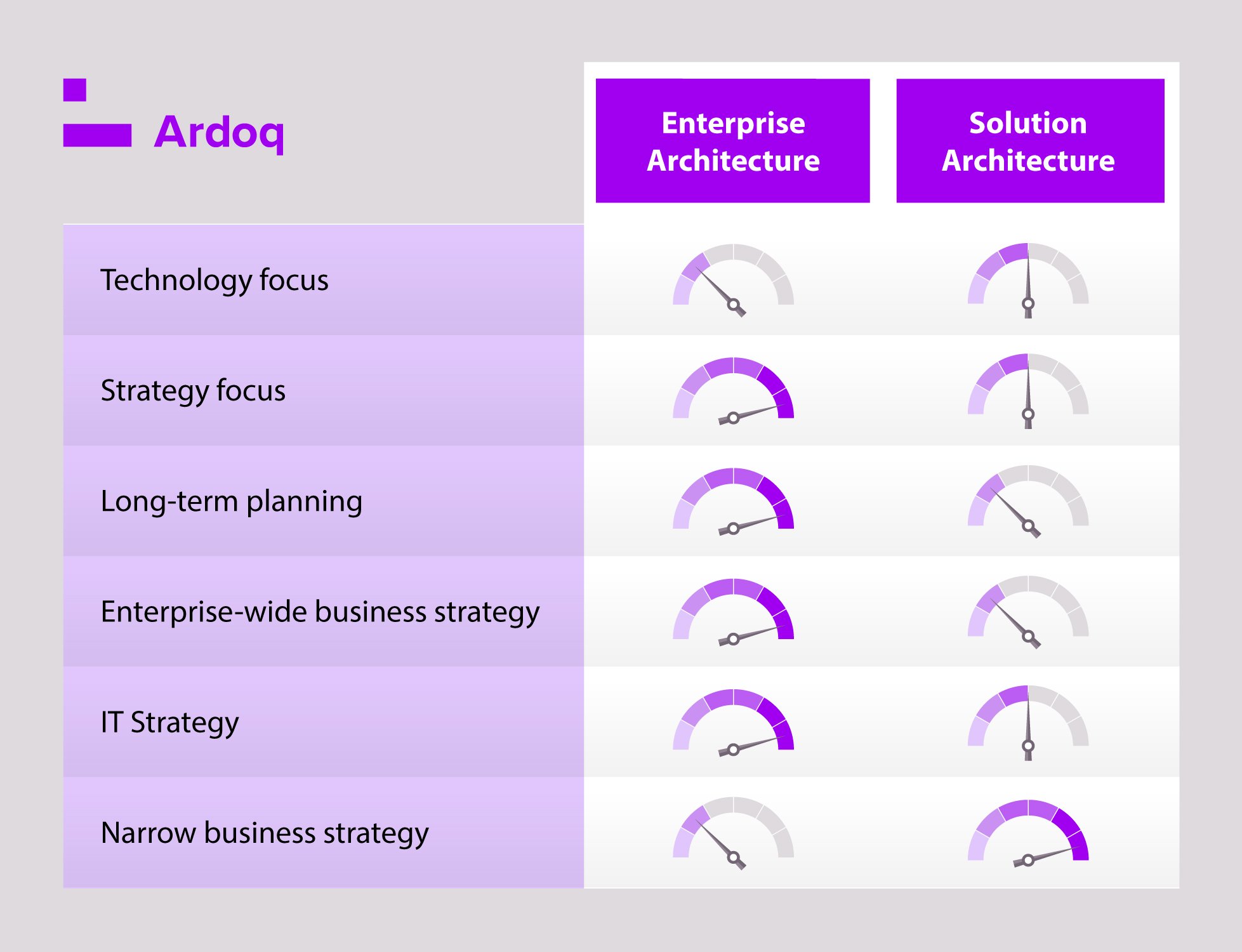Just as physical buildings follow carefully designed architectural blueprints, conceiving stable, safe structures and hopefully pleasing to the eye, every business needs to map out their unseen data into a ‘blueprint’ that encompasses their entire organization.
That’s what architects do: they map out and design organizations. Unfortunately, there’s no all-encompassing definition of Enterprise Architecture vs. Solution Architecture that everyone agrees on.
Ask Google, and you’ll find many interpretations. Look into online forums, and you’ll find people disagreeing vehemently on semantics, and with good reason. Each unique organization needs to develop a method and definition of architecture that best suits its purpose.
Enterprise Architecture and Solution Architecture operate in a hierarchical relationship. Enterprise Architecture establishes the overarching strategic framework and guidelines, while Solution Architecture interprets and applies these directives to create project-specific architectures.
Understanding the differences between Enterprise Architecture vs. Solution Architecture is essential if you’re to map out your organization correctly.
In this article, we’ll uncover in more detail the differences between these two disciplines and the role each plays in an organization.
- What’s Enterprise Architecture?
- What’s Solution Architecture?
- Enterprise Architect vs Solution Architect: What’s the Difference?
- Enterprise vs. Solution Architecture: An Overview
What’s Enterprise Architecture?
As the name suggests, Enterprise Architecture (EA) examines the entire enterprise. It helps shape the organization and can involve defining the business properties, capabilities, people, and potential future outcomes. Often, this starts by gathering data and mapping it out to show the relationships between all the different entities of an organization.
Enterprise Architecture can help an organization maintain its everyday applications and equip it to manage change. It works with various architectures, including application, business, data, and infrastructure.
What’s Solution Architecture?
Solution Architecture is more tactical and deals with addressing specific business needs. Solution Architecture may seek to solve existing business challenges or propose technical solutions to new problems. It defines how to structure a solution and make it happen within the context of an enterprise’s architecture.
Enterprise Architect vs Solution Architect: What’s the Difference?
What Does an Enterprise Architect Do?
Enterprise Architects usually work within the four areas noted above. Depending on organizational needs, work could include any of the following domains of Enterprise Architecture:
- Application Architecture: designing, mapping, and security.
- Business Architecture: development, strategy, capabilities, and value chains.
- Data Architecture: strategy and governance.
- Infrastructure Architecture: automation, governance, and building reliability.
Skill Sets
-
Strong knowledge of architectural frameworks: An enterprise architect needs a broad knowledge of frameworks to deliver effective change.
-
Problem-solving: To identify and address organizational issues, architects should be proficient in troubleshooting and technical analysis.
-
Solution management: An architect should be engaged throughout each stage of the solution implementation process.
-
Conflict resolution: As structures and systems are implemented, disagreements will inevitably occur. It’s the job of the architect to address these conflicts.
Responsibilities
-
Identify potential risks to IT systems.
-
Create and oversee the execution of strategies.
-
Utilize an Enterprise Architecture tool to achieve key outcomes.
-
Facilitate digital transformation by introducing new technological solutions.
-
Carry out gap analysis to ensure that business objectives are being met.
-
Create a center of excellence to provide knowledge and expertise.
What are the must-haves for a successful Enterprise Architect?
An Enterprise Architect should be forward-thinking. This means staying up to date on the latest technologies and architectures. They should be eager to propel their organization to the next stage of transformation.
For example, let’s say company XYZ wants to exploit the possibilities inherent in AI technology - for instance, mapping customer engagement patterns to predict what they might purchase next.
The Enterprise Architect could map how XYZ uses AI today and what steps should happen to reach its future goals. They could note which changes should be made to the infrastructure by adding applications, processes, skills, and teams, assessing risks, and predicting the scenarios resulting from these future decisions.
Enterprise Architects today must understand their businesses and the qualities their stakeholders care about.
- Dana Bredemeyer and Ruth Malan, What It Takes to Be a Great Enterprise Architect
What Does a Solution Architect Do?
Solution Architects develop and integrate solutions and processes based on the enterprise’s needs. How they go about this depends on the individual’s background and how the organization defines its solution architecture.
Depending on the situation and after being presented with a business challenge, Solution Architects is focused on current technologies available and what needs to be developed to allow the business to meet specific business or project objectives.
Skill Sets
- Tech experience: Tech skills are arguably the most important skill for a Solution Architect. They need a strong understanding of IT Architecture, business analysis, and software engineering.
- An analytical approach: A big part of the job is analyzing business processes to see how they can be improved. This means analyzing data to see where improvements can be made.
- Strong communication skills: As with an Enterprise Architect, a solution architect needs to work closely with other teams to understand their needs and create strategies for meeting them.
- Decision-making: Their role is to develop the best-fit solutions that are effective and efficient. This means being able to make decisions on the most suitable technology given the constraints of their organization’s architecture, budget, and timeline.
Responsibilities
- Identify and select new technologies
- Build prototype models of solutions
- Understand business requirements
- Balance constraints
- Support project management teams
- Design a technical strategy
- Create technical documentation
- Manage and collaborate with software development teams
What are the must-haves for a successful Solution Architect?
The Solution Architect’s job could include studying all aspects of the solution, including budget, technology, risk, time, quality, etc. They would find the limitations and restrictions that impact the project and then plan their solution around these.
For example, a Solution Architect might be tasked with building a solution that deals with knowledge management in the company. There are many different ways to design and build this over time.
As they build, the Solution Architecture ensures it’s functionally suitable, has security capabilities, is reliable, and is available to people across the organization. Sometimes, they will map the qualities of the solution, creating a clear overview of the process.

How Does Enterprise Architecture Add Value?
Enterprise Architecture helps companies plan and execute the future by supporting their daily decisions. EA provides the overview for decision-makers to understand what’s happening across their organization.
Depending on the organizational need, the value of enterprise architecture can be seen in: architecture adds value to:
- Technology: Enhancing the quality of IT services.
- Finance: Providing improved business solutions and business technologies that save time and lower costs.
- Strategy: Defining and aligning strategy, improving customer experience, or improving supply chain performance.
- Operations: Helping operations improve processes, data collection, and reporting.
- Business outcomes: Pinpointing cost reduction and investment opportunities.
Learn more about the vital ways EA practitioners can communicate the value of Enterprise Architecture.
How Does Solution Architecture Add Value?
A well-built architecture ensures that solutions are delivered within budget, on time, and solve the problem as promised.
Solution Architects add value by planning and streamlining solutions. They understand the value proposition, solution components, scope, and pricing model. They make sure that the solutions match the corporate strategy and meet stakeholders’ requirements.
Here are some examples that a Solution Architect could offer to software solutions:
- Build a seamless customer experience. With an intuitive-to-use solution, customers are more likely to buy.
- Provide software solutions that are thoroughly stress tested so they have high reliability and performance.
- Deliver a streamlined solution without expensive extras, giving greater profitability.
To fully capitalize on this value, tools that bridge design and data are crucial. The Ardoq + Lucidchart integration empowers Solution Architects to leverage Lucidchart's intuitive canvas for designing future states, mapping integrations, and detailing system flows, all while anchoring these visuals in live architectural data from Ardoq. This ensures diagrams are always up-to-date and grounded in a single source of truth, fostering clearer communication and faster, more confident design decisions. By connecting these visual designs to the underlying architecture, solution architects can streamline their work, ensure alignment, and ultimately deliver solutions that truly drive business value.
Enterprise vs. Solution Architecture: An Overview
But what is the difference between Enterprise Architecture vs Solution Architecture? The table below gives a general overview.

Ask someone to explain the difference between a Solution Architect vs an Enterprise Architect, and the conflicting answers vary. This article has tried to outline some key differences between roles and the two architectural disciplines. Ultimately, the work of both Enterprise and Solution Architects at different organizational levels drives toward the same overall objectives of furthering core business outcomes rather than documentation or data management.
Learn more about how organizations can unlock the full strategic potential of Enterprise Architecture to drive innovation, reduce costs, and improve operational efficiency.
- Blog Posts Enterprise Architecture Tools: A Full Guide to Choosing Software The Evolution of Enterprise Architecture Enterprise Architecture Trends to Watch in 2023 - An EA's Guide
- PDF Guides 2025 Gartner® Magic Quadrant™ for Enterprise Architecture Tools 5 Rules to Make Enterprise Architecture Work for Your Business in 2025
 Ardoq
This article is written by Ardoq as it has multiple contributors, including subject matter experts.
Ardoq
This article is written by Ardoq as it has multiple contributors, including subject matter experts.



/Logos/Ardoq/RGB_Ardoq_Logo_Stacked_White_Monochrome%201.png?width=80&height=77&name=RGB_Ardoq_Logo_Stacked_White_Monochrome%201.png)

